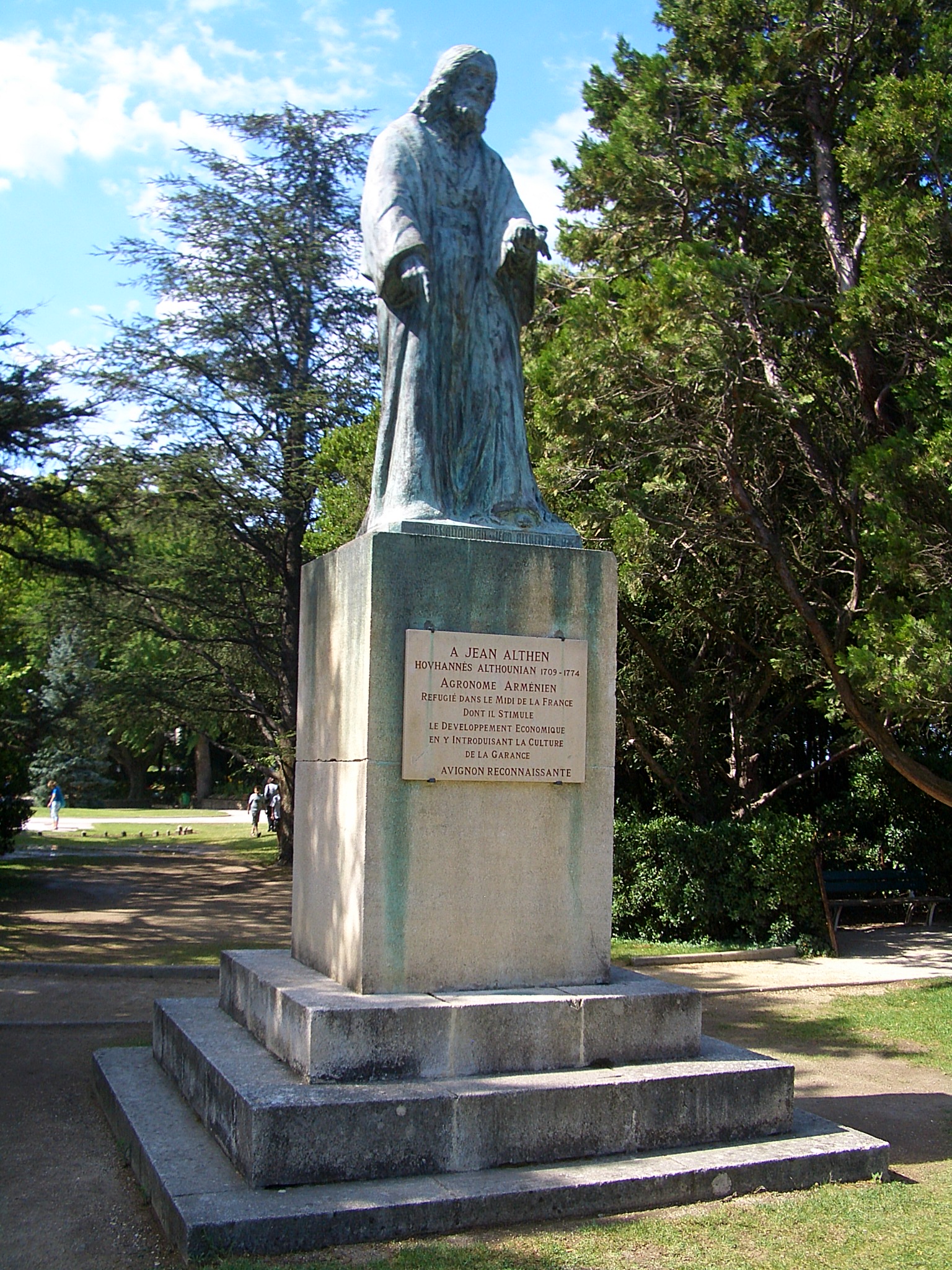Jean Althen on:
[Wikipedia]
[Google]
[Amazon]
 Jean-Baptiste Joannis Althen, better simply known as Jean Althen (Hovhannès Althounian; 1709–1774), was an
Jean-Baptiste Joannis Althen, better simply known as Jean Althen (Hovhannès Althounian; 1709–1774), was an
 Jean-Baptiste Joannis Althen, better simply known as Jean Althen (Hovhannès Althounian; 1709–1774), was an
Jean-Baptiste Joannis Althen, better simply known as Jean Althen (Hovhannès Althounian; 1709–1774), was an Armenian
Armenian may refer to:
* Something of, from, or related to Armenia, a country in the South Caucasus region of Eurasia
* Armenians, the national people of Armenia, or people of Armenian descent
** Armenian Diaspora, Armenian communities across the ...
agronomist
An agriculturist, agriculturalist, agrologist, or agronomist (abbreviated as agr.), is a professional in the science, practice, and management of agriculture and agribusiness. It is a regulated profession in Canada, India, the Philippines, the ...
from Safavid Iran who developed the cultivation of madder
''Rubia'' is the type genus of the Rubiaceae family of flowering plants, which also contains coffee. It contains around 80 species of perennial scrambling or climbing herbs and subshrubs native to the Old World. The genus and its best-known ...
in France
France (), officially the French Republic ( ), is a country primarily located in Western Europe. It also comprises of overseas regions and territories in the Americas and the Atlantic, Pacific and Indian Oceans. Its metropolitan area ...
.
Although the plant had been present in the region before his arrival, it was Jean-Baptiste Althen who developed its cultivation, turning it into an industry.
Biography
Jean-Baptiste was born to a certain "Althen and Catherine Madrecha" in the Safavid Empire, in a village he called "Chaouch". Jean-Baptiste grew up in a time of much turmoil, as the Safavid Empire, then ruled by King (''Shah
Shah (; fa, شاه, , ) is a royal title that was historically used by the leading figures of Iranian monarchies.Yarshater, EhsaPersia or Iran, Persian or Farsi, ''Iranian Studies'', vol. XXII no. 1 (1989) It was also used by a variety of ...
'') Sultan Husayn (1694–1722), was in a state of heavy decline. During the Afghan invasion, Jean-Baptiste's parents were killed while he was enslaved and brought to Kayseri in the Ottoman Empire
The Ottoman Empire, * ; is an archaic version. The definite article forms and were synonymous * and el, Оθωμανική Αυτοκρατορία, Othōmanikē Avtokratoria, label=none * info page on book at Martin Luther University) ...
. According to Sibylla Schuster-Walser / ''Encyclopædia Iranica
''Encyclopædia Iranica'' is a project whose goal is to create a comprehensive and authoritative English language encyclopedia about the history, culture, and civilization of Iranian peoples from prehistory to modern times.
Scope
The ''Encyc ...
'', in Kayseri, "he learned cotton cultivation and dyeing". In ca. 1736, Jean-Baptiste managed to escape and moved to France
France (), officially the French Republic ( ), is a country primarily located in Western Europe. It also comprises of overseas regions and territories in the Americas and the Atlantic, Pacific and Indian Oceans. Its metropolitan area ...
.
In France, he received authorization by incumbent King Louis XV
Louis XV (15 February 1710 – 10 May 1774), known as Louis the Beloved (french: le Bien-Aimé), was King of France from 1 September 1715 until his death in 1774. He succeeded his great-grandfather Louis XIV at the age of five. Until he reached ...
(1715–1774) "to start state-aided cotton fields". When it became apparent that his efforts to grow cotton had been in vain, Jean-Baptiste started cultivating "Oriental madder
''Rubia'' is the type genus of the Rubiaceae family of flowering plants, which also contains coffee. It contains around 80 species of perennial scrambling or climbing herbs and subshrubs native to the Old World. The genus and its best-known ...
" in Avignon in 1754, with great success. Associated with a local landlord, Clauseau Aïné, he produced a crop of 2500 kg (5500 lbs) in 1769. Sibylla Schuster-Walser notes that madder "soon became a main crop of the region". Jean-Baptiste died in poverty in 1774.
In 1846, about 70 years after his death, Jean-Baptiste was honored for his efforts as the French erected a statue of him in Avignon. A French commune, Althen-des-Paluds, is named after him, as well as statues and streets in several cities of the south of France.
References
Sources
* * *Further reading
* {{DEFAULTSORT:Althen, Jean 1709 births 1774 deaths Persian Armenians Iranian emigrants to France French people of Armenian descent 18th-century people of Safavid Iran